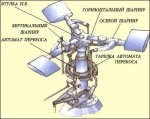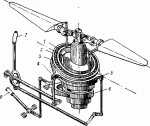alexkmmll
Newbie
Hello everyone,
As I'm sure you've noticed, this is my first post here. I thought I'd introduce myself. My name is Alex and I very much enjoy flight, however, I do not possess a pilot's license (Someday soon, maybe). With that said, I enjoy spending many days at EAA's annual AirVenture, and I also fly and work with RC aircraft.
Recently, I was reading an article in Popular Science. The article, about an engine, the NorEaster, said that the engine, which used cams instead of crank shaft, had low enough RPMs to be directly linked to a light coaxial helicopter. Well, I found the full report written, and found it less than conclusive on the subject, yet got my mind turning.
I would like to design a simple, legal Part 103, coaxial helicopter. Not necessarily build it, but design it; for fun, really.
Problem: I know very little about real coaxials. The RC ones are easy: Fixed pitch, swashplate on bottom blades, and two motors with varied speeds for yaw. However, this, obviously, does not transfer over to the prototypes. I scanned through a few images and found some with fixed pitch, some with collectives, a mix of all sorts of different rotor head configurations, and they all left me relatively confused. :der:
The other thing beyond me is yaw. It's from varying rotor speed, but how do you do this when you are powering everything from a single engine? I did a bit of research and found tip brakes and the use of differentials. So, if I understand this correctly, the brakes are deployed, causing the blades to decrease RPM, which is allowed through the diff, and the helicopter yaws? What other solutions are there to get around this? And how exactly are tip brakes connected to the actual rotor head when it's a cable? I read somewhere it's recommended the tip brakes are independent from other functions.
What gearboxes do these helicopters use? Have direct drive systems ever been attempted?
I am very sorry for all these seemingly dumb questions. Is there a 'beginner's guide to coaxials' anywhere? Ha!
Maybe someone can lay this out in a slightly more organized, understandable fashion for me? I'm very used to designing planes, not helicopters! Planes seem much more straight forward to me...
Thanks and sorry again,
Alex
As I'm sure you've noticed, this is my first post here. I thought I'd introduce myself. My name is Alex and I very much enjoy flight, however, I do not possess a pilot's license (Someday soon, maybe). With that said, I enjoy spending many days at EAA's annual AirVenture, and I also fly and work with RC aircraft.
Recently, I was reading an article in Popular Science. The article, about an engine, the NorEaster, said that the engine, which used cams instead of crank shaft, had low enough RPMs to be directly linked to a light coaxial helicopter. Well, I found the full report written, and found it less than conclusive on the subject, yet got my mind turning.
I would like to design a simple, legal Part 103, coaxial helicopter. Not necessarily build it, but design it; for fun, really.
Problem: I know very little about real coaxials. The RC ones are easy: Fixed pitch, swashplate on bottom blades, and two motors with varied speeds for yaw. However, this, obviously, does not transfer over to the prototypes. I scanned through a few images and found some with fixed pitch, some with collectives, a mix of all sorts of different rotor head configurations, and they all left me relatively confused. :der:
The other thing beyond me is yaw. It's from varying rotor speed, but how do you do this when you are powering everything from a single engine? I did a bit of research and found tip brakes and the use of differentials. So, if I understand this correctly, the brakes are deployed, causing the blades to decrease RPM, which is allowed through the diff, and the helicopter yaws? What other solutions are there to get around this? And how exactly are tip brakes connected to the actual rotor head when it's a cable? I read somewhere it's recommended the tip brakes are independent from other functions.
What gearboxes do these helicopters use? Have direct drive systems ever been attempted?
I am very sorry for all these seemingly dumb questions. Is there a 'beginner's guide to coaxials' anywhere? Ha!
Maybe someone can lay this out in a slightly more organized, understandable fashion for me? I'm very used to designing planes, not helicopters! Planes seem much more straight forward to me...
Thanks and sorry again,
Alex



